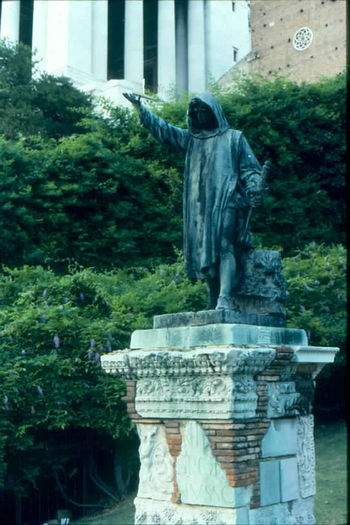Cola di Rienzo
| Line 1: | Line 1: | ||
| + | [[Category:Nova Roma]] | ||
[[Image:ColaDiRienzo.jpg|thumb|350px|right|Cola di Rienzo, founder of the '''new''' [[Roman Republic]] of 1347. Though short-lived, his attempt is recorded by a statue by Girolamo Masini, erected in 1877 near the [[Capitoline Hill]], next to the ramped Cordonata leading to Michelangelo's Piazza del Campidoglio, where he was killed. The base for the statue is composed of bricks and other fragments from ancient Roman ruins, symbolizing the idea that Rienzo's period of rulershp was based on the ideals of the ancient Roman Republic.]] | [[Image:ColaDiRienzo.jpg|thumb|350px|right|Cola di Rienzo, founder of the '''new''' [[Roman Republic]] of 1347. Though short-lived, his attempt is recorded by a statue by Girolamo Masini, erected in 1877 near the [[Capitoline Hill]], next to the ramped Cordonata leading to Michelangelo's Piazza del Campidoglio, where he was killed. The base for the statue is composed of bricks and other fragments from ancient Roman ruins, symbolizing the idea that Rienzo's period of rulershp was based on the ideals of the ancient Roman Republic.]] | ||
Latest revision as of 09:50, 9 August 2023

Cola di Rienzo, or in his full name, Nicola di Lorenzo Gabrini (in Romanesco dialect: Cola de Rienzi) stormed the Capitoline Hill in 1347 to create a new Roman Republic.
In spite of its decline and the absence of the Pope, Rome had not lost its spiritual prestige: in 1341 the famous poet Petrarca came to the city to be crowned as poet in Capitoline Hill. Noblemen and poor people at one time demanded with one voice the return of the Pope. Among the many ambassadors that in this period took their way to Avignon, emerged the bizarre but eloquent figure of Cola di Rienzo. As his personal power among the people increased by time, on May 20, 1347 he conquered the Capitoline at the head of an enthusiast crowd. The period of his power, though very short-lived, is anyway one of the most interesting in the life of Rome in Middle Ages, as Cola tried to assure himself a renovating, almost mystical aura of a paladin of Italian independence, within a confused political dream inspired to the prestige of the Ancient Rome. Now in possession of dictatorial powers, he took the title of "tribune", referring to the pleb's magistracy of the Roman Republic. Cola also considered himself at an equal status of that of the Holy Roman Emperor. On August 1, he conferred Roman citizenship on all the Italian cities, and even prepared for the election of a Roman emperor of Italy. It was too much: the Pope denounced him as heretic, criminal and pagan, the populace had begun to be disenchanted with him, while the nobles had always hated him. On December 15, he was forced to flee.
In August 1354, Cola was again a protagonist, when Cardinal Gil Alvarez De Albornoz entrusted him with the role of "senator of Rome" in his program of reassuring the Pope's rule in the Papal States. In October the tyrannical Cola, who had become again very unpopular for his delirious behaviour and heavy bills, was killed in a riot provoked by the powerful family of the Colonna.
Source: Wikipedia